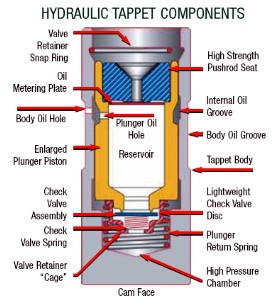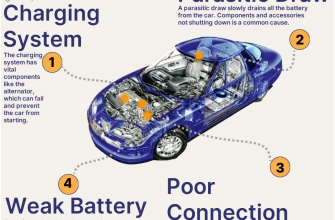When it comes to high-performance engines, every component plays a crucial role in the overall efficiency and power output. One often overlooked but critical component is the engine lifter. These small yet mighty parts are essential for the optimal functioning of an internal combustion engine. In this article, we will delve into what engine lifters are, their types, and their significance in enhancing engine performance.
What Are Engine Lifters?
Engine lifters, also known as tappets, are components in the valve train of an engine that transfer the motion from the camshaft to the pushrods, which then operate the engine’s valves. They play a vital role in the timing and efficiency of the engine’s operation. Lifters ensure that the valves open and close at the correct intervals, allowing for the proper intake of air and fuel and the efficient exhaust of combustion gases.
Types of Engine Lifters
There are primarily two types of engine lifters: hydraulic and solid. Understanding the difference between these lifters is essential for any car enthusiast or performance builder.
- Hydraulic Lifters: These are the most commonly used lifters in modern engines. They contain a small amount of oil that allows them to automatically adjust to changes in the engine’s operating conditions. This self-adjusting feature helps maintain zero valve lash, ensuring consistent performance. Hydraulic lifters are favored for their quieter operation and reduced maintenance needs.
- Solid Lifters: Also known as mechanical lifters, solid lifters do not contain any oil and do not self-adjust. Instead, they require manual adjustment to maintain the correct valve clearance, which can lead to a more aggressive cam profile and higher RPM capabilities. Solid lifters are typically used in racing engines, where maximum performance is prioritized over comfort and noise.
How Engine Lifters Affect Performance
The impact of engine lifters on performance cannot be overstated. Here are several ways in which they contribute to the overall performance of an engine:
- Valve Timing: Properly functioning lifters ensure that valves open and close at the precise moment, optimizing the engine’s breathing capabilities. This is crucial for maximizing power output and efficiency.
- RPM Range: Different types of lifters can affect the engine’s RPM range. Solid lifters can handle higher RPMs better than hydraulic lifters, making them ideal for performance applications.
- Noise Reduction: Hydraulic lifters provide a quieter operation compared to solid lifters, which can be an important consideration for street vehicles where noise levels are a concern.
- Durability: The choice of lifters can also impact the longevity of the engine. Higher quality lifters can withstand greater stress and heat, resulting in a more reliable engine over time.
Choosing the Right Lifters for Your Engine
When selecting lifters for an engine build or upgrade, several factors must be considered:
- Type of Engine: The engine’s design and intended use will heavily influence the choice of lifters. Performance engines often benefit from solid lifters, while daily drivers may prefer the convenience and quiet operation of hydraulic lifters.
- Camshaft Compatibility: It’s essential to ensure that the lifters you choose are compatible with your camshaft. Mismatched components can lead to poor performance and potential engine damage.
- Budget: High-performance lifters can be expensive, so it’s important to balance cost with the expected performance gains. Investing in quality lifters can pay off in the long run.
Engine lifters may be small components, but their role in the performance of an engine is significant. Whether you are building a high-performance racing engine or simply looking to improve your daily driver, understanding the types of lifters and their impact on engine performance is essential. By selecting the right lifters, you can enhance your engine’s efficiency, power, and longevity, ensuring that you get the most out of your investment.
In the world of automotive performance, every detail counts, and engine lifters are no exception. Choose wisely, and let your engine roar!
As we continue to explore the intricate world of engine performance, it becomes evident that lifters, despite their modest size, are pivotal in determining how an engine behaves under various conditions. Their influence extends beyond mere mechanical function; they play a significant role in the engine’s responsiveness, efficiency, and overall driving experience.
The Mechanics Behind Lifters
To fully appreciate the role of engine lifters, it’s essential to understand the basic mechanics of how they operate. Lifters are situated in the engine’s valve train, acting as a bridge between the camshaft and the engine valves. When the camshaft rotates, it pushes the lifters upward, which, in turn, actuates the pushrods and opens the valves. This synchronized dance is crucial; any misalignment can lead to suboptimal performance, increased wear, and even catastrophic engine failure.
Performance Modifications and Lifters
For enthusiasts looking to boost their engine’s performance, the choice of lifters can be a game-changer. Upgrading to high-performance lifters can unlock potential that factory-installed options may not provide. Here are a few key aspects to consider when modifying lifters for performance:
- Camshaft Upgrades: If you’re installing a performance camshaft, it’s often recommended to pair it with lifters designed to handle the increased demands. A more aggressive cam profile requires lifters that can respond quickly and maintain precise timing.
- Spring Rates: Stiffer valve springs may be necessary when upgrading to solid lifters, which can handle higher RPMs without compromising performance. However, this also means careful consideration must be given to the entire valve train to prevent failure.
- Material Choice: Lifters made from high-quality materials, such as billet steel or ceramic composites, provide enhanced durability and resistance to wear, especially under extreme conditions. This choice can significantly affect the longevity of both the lifters and the engine itself.
Common Issues and Maintenance
Despite their robust design, lifters are not immune to problems. Some common issues include:
- Lifter Noise: A ticking or tapping noise can indicate a problem with the lifters. This could be due to insufficient oil pressure, wear, or contamination; Regular oil changes and using the correct oil viscosity can help mitigate these issues.
- Sticking Lifters: Lifters may become stuck due to sludge buildup or lack of lubrication, leading to poor valve performance. This is often remedied through proper maintenance and, if necessary, cleaning or replacing the lifters.
- Wear Patterns: Over time, lifters can develop uneven wear patterns due to misalignment or insufficient lubrication. Regular inspections can help identify these issues before they escalate.
Future Trends in Engine Lifters
As automotive technology continues to evolve, so do lifters. Innovations such as variable valve timing (VVT) and advanced hydraulic lifter designs are shaping the next generation of engine performance. These advancements promise even greater efficiency and power delivery, allowing drivers to experience improved throttle response and fuel economy without sacrificing performance.
Embrace the power of knowledge, and let your engine thrive!










What an insightful article! The details about the different types of engine lifters really helped me understand their roles better. Highly recommend!
I learned so much about hydraulic and solid lifters from this piece. The explanations are clear and informative. Well done!
I’ve always been curious about how engine parts work together, and this article answered so many questions. Great job explaining lifters!
Excellent breakdown of engine components! I appreciate how you highlighted the significance of lifters in overall efficiency. Very enlightening!
This article provides a fantastic overview of engine lifters! I never realized how crucial they were for engine performance. Great read!
This is a must-read for any car enthusiast! The information on hydraulic vs solid lifters was particularly useful for my project. Thanks for sharing!
Fantastic article on a topic that often gets overlooked. Understanding engine lifters has definitely improved my knowledge of performance engines!